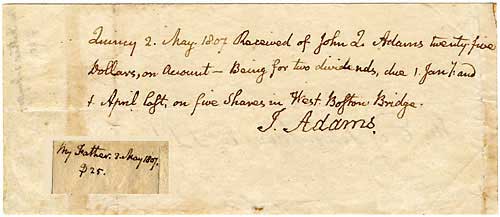Sold – Adamses Invest in One of the Earliest American Improvements – Signed by Both Father and Son

Research fails to disclose another document bearing both full signatures.
The West Boston Bridge was completed in 1793 and offered the first direct route from Cambridge to Boston across the Charles River, cutting the distance between the two from eight to three miles. The opening of the bridge allowed Cambridge to become a primary commercial link between Boston and points inland and...
The West Boston Bridge was completed in 1793 and offered the first direct route from Cambridge to Boston across the Charles River, cutting the distance between the two from eight to three miles. The opening of the bridge allowed Cambridge to become a primary commercial link between Boston and points inland and facilitated the industrial growth that characterized the region west of Boston during the 19th century. The Longfellow Bridge was later built and currently stands on the same site.
Coming just a decade after the treaty ending the Revolution and started during Washington’s first term as one of the new nation’s earliest major internal improvements, it is no wonder that the company building the bridge attracted investors of the caliber of Vice President John Adams. His son John Quincy may have been a co-investor with him or may have been simply handling certain investments for his father. In either event, it generated this document between the presidential father and son.
Autograph Document Signed within the text by John Quincy Adams, May 2, 1807, Quincy, Mass., designed for the signature of John Adams. “Received of John Q. Adams twenty-five dollars, on account – Being for two dividends, due 1 Jan. 7: and 1 April last, on five shares in West Boston Bridge.” The elder Adams then signs. On the back, John Quincy has docketed, rather touchingly, “My father. 2 May 1807. $25.”
According to the Massachusetts Historical Society (MHS, which is home to the John Adams Papers project), the investment of Adams in this key early improvement was unknown until this document surfaced. Thus, it has historical significance and illustrates Adams’s support for internal improvements. It also provides us an insight into the close working relationship between the two founding fathers.
The MHS also notes that it is rare to find a document containing the signatures of both John Adams and John Quincy Adams (they did not, in fact, recall seeing any). A search of auction records confirms this, failing to show any other such document having been offered in the past 30 years.

Frame, Display, Preserve
Each frame is custom constructed, using only proper museum archival materials. This includes:The finest frames, tailored to match the document you have chosen. These can period style, antiqued, gilded, wood, etc. Fabric mats, including silk and satin, as well as museum mat board with hand painted bevels. Attachment of the document to the matting to ensure its protection. This "hinging" is done according to archival standards. Protective "glass," or Tru Vue Optium Acrylic glazing, which is shatter resistant, 99% UV protective, and anti-reflective. You benefit from our decades of experience in designing and creating beautiful, compelling, and protective framed historical documents.
Learn more about our Framing Services







































































































